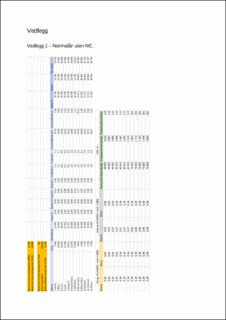| dc.contributor.advisor | Greaker, Mads | |
| dc.contributor.author | Hordvik, Andreas | |
| dc.date.accessioned | 2021-10-18T08:43:22Z | |
| dc.date.available | 2021-10-18T08:43:22Z | |
| dc.date.issued | 2021 | |
| dc.identifier.uri | https://hdl.handle.net/11250/2823593 | |
| dc.description.abstract | Denne masteroppgaven analyserer den samfunnsøkonomiske lønnsomheten av
NorthConnect, en konsesjonssøkt ny utenlandskabel mellom Norge og Storbritannia som i
utgangspunktet skal settes i drift innen 2024, med en overføringskapasitet på 1 400 MW.
Oppgaven motiveres av NVEs rapport angående NorthConnect, en rapport som skapte
debatt i Stortinget til tross for de positive anslagene av den samfunnsøkonomiske
lønnsomheten til prosjektet. Jeg har utviklet en numerisk modell med et teoretisk rammeverk
til å modellere det norske kraftsystemet og -markedet, som benyttes til å beregne forventet
samfunnsøkonomisk lønnsomhet av NorthConnect.
Modellåret er 2030, slik at det gjøres antakelser om utviklingen i fremtidens kraftmarked
knyttet til høyere kraftforbruk og mer installert vindkraft. Kjøringen av modellen ble gjort for ni
værår eller scenarioer, alle med forskjellige nivåer på vanntilsig og vindkraft. Resultatene fra
modellene viser at økt overføringskapasitet til Storbritannia gir en forventet
samfunnsøkonomisk lønnsomhet på mellom 260 og 900 mill. kr i de forskjellige værårene,
hvor lønnsomheten for det meste er stigende med størrelsen på kraftoverskuddet. I de fleste
værscenarioene skyldes lønnsomheten at prisene i Norge øker med ca. 9-26 kr/MWh i
gjennomsnitt grunnet oppgradert overføringskapasitet til Storbritannia, som fører til at
produsentene tjener mer enn konsumentene taper. I analysen kommer jeg frem til mange av
de samme konklusjonene som NVE, samtidig med noen avvik.
I tillegg til hovedanalysen ble det gjennomført en robusthetssjekk av resultatene fra 3 utvalgte
værscenarioer, med fire sensitiviteter. Her fremkommer det at NorthConnect fortsatt er
samfunnsøkonomisk lønnsom i de utvalgte værårene, som indikerer at de nevnte resultatene
er robuste for endringene i kraftmarkeds- og modellforutsetningene. Resultatene fra
robusthetssjekken impliserer interessant nok at lønnsomheten av NorthConnect kan bli
høyere i år med norsk kraftunderskudd, dersom prisene i Storbritannia blir lavere enn antatt. | en_US |
| dc.description.abstract | This master’s thesis will analyse the socioeconomic profitability of NorthConnect, a new
interconnector between Norway and Great Britain with a transmission capacity of 1 400 MW
which is expected to be commissioned by the end of 2024. The thesis is motivated by NVE’s
assessment of NorthConnect, a report that caused disagreement in the Norwegian parliament
despite the report’s findings showing that NorthConnect is likely to be socioeconomically
profitable. Using a theoretical framework, I have developed a numerical model of the
Norwegian power system and market to estimate the socioeconomic profitability of
NorthConnect.
The model takes place in the year of 2030, meaning that assumptions regarding
developments in the future power market need to be made related to consumption and wind
power capacity. I ran the model through nine different weather scenarios, each one with
different levels of expected yearly water inflow and wind power. The results of the model show
that increasing the transmission capacity towards Great Britain yields an expected
socioeconomic profitability of between NOK 260 and 900 million in the different weather
scenarios, where profitability mostly increases with higher power production. In most of the
weather scenarios, the profits are generated through an increase in Norwegian power prices
by an average of 9-26 Norwegian kroner per MWh, which leads to domestic producers
gaining more than consumers lose. In this analysis, I came to many of the same conclusions
that NVE did in their assessment, in addition to some deviations.
Furthermore, I conducted a sensitivity analysis with the results of three selected weather
scenarios from the main analysis, with four sensitivities. From the sensitivity analysis, it
appears that NorthConnect still is socioeconomically profitable, which indicates that the
selected results are sound with respect to the changes in assumptions regarding the future
power market and the model. Interestingly, results from the sensitivity analysis imply that the
profitability of NorthConnect could be higher in years with low power production in Norway if
the power prices in Great Britain become lower than expected. | en_US |
| dc.language.iso | nob | en_US |
| dc.publisher | OsloMet - storbyuniversitetet | en_US |
| dc.subject | Kraftmarked | en_US |
| dc.subject | Kraftsystem | en_US |
| dc.subject | Mellomlandsforbindelser | en_US |
| dc.subject | Lønnsomhet | en_US |
| dc.subject | Elektrisitetspriser | en_US |
| dc.title | Hva er forventet samfunnsøkonomisk lønnsomhet av NorthConnect? | en_US |
| dc.type | Master thesis | en_US |
| dc.description.version | submittedVersion | en_US |

